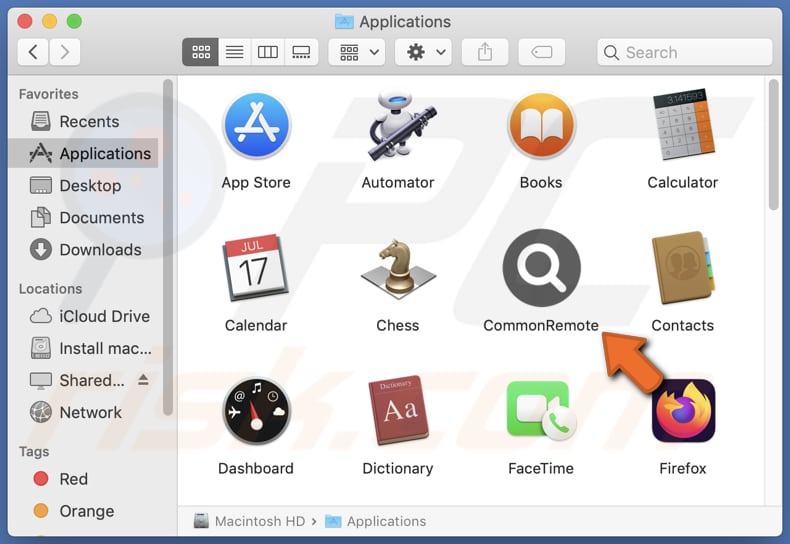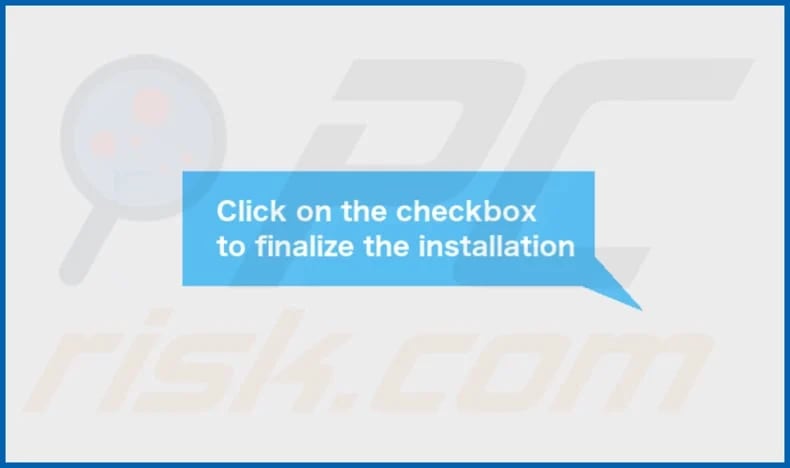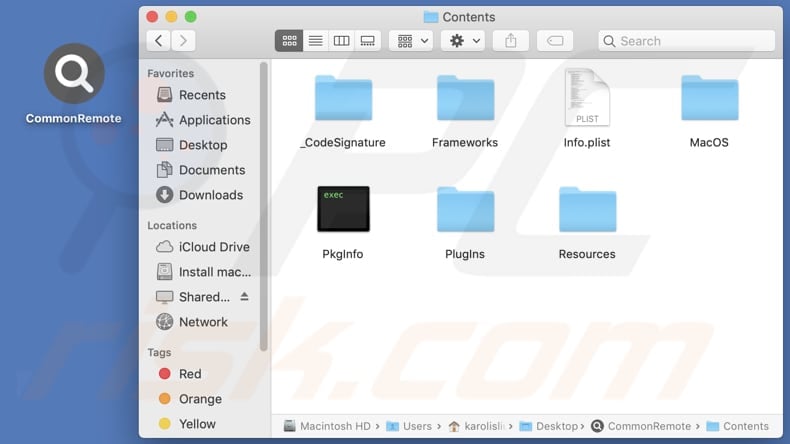Get free scan and check if your device is infected.
Remove it nowTo use full-featured product, you have to purchase a license for Combo Cleaner. Seven days free trial available. Combo Cleaner is owned and operated by RCS LT, the parent company of PCRisk.com.
What kind of application is CommonRemote?
After examining the CommonRemote application more closely, we have determined that it exhibits advertisements to users, categorizing it as adware. It is important to recognize that applications like CommonRemote may extend beyond simply displaying ads, potentially engaging in additional unwanted behaviors.

CommonRemote adware in detail
Users are advised to be cautious and refrain from clicking on ads presented by CommonRemote. These advertisements might redirect users to dubious websites that could host malicious content or employ deceptive tactics. Such websites pose security risks, potentially exposing users to malware infections, phishing schemes, or identity theft.
Clicking on ads from CommonRemote can inadvertently jeopardize users' devices and personal information. Additionally, CommonRemote may surreptitiously gather various user data without their explicit consent. This could encompass browsing history, search queries, IP addresses, geolocation information, device identifiers, and potentially sensitive personal details.
In addition to displaying annoying ads, some adware variants have the capability to modify browser settings, effectively hijacking the browser. These alterations usually include changing the default homepage, search engine, or new tab page. Typically, browser-hijacking apps promote fake search engines or other unreliable pages.
Therefore, it is advisable to refrain from downloading and installing applications like CommonRemote and to promptly remove any existing adware from computers.
| Name | Ads by CommonRemote |
| Threat Type | Adware, Mac malware, Mac virus |
| Detection Names | Avast (MacOS:AdAgent-L [Adw]), Combo Cleaner (Gen:Variant.Adware.MAC.AdLoad.8), ESET-NOD32 (A Variant Of OSX/Adware.Synataeb.C), Kaspersky (Not-a-virus:HEUR:AdWare.OSX.Adload.h), Full List (VirusTotal) |
| Additional Information | This application belongs to Adload malware family. |
| Symptoms | Your Mac becomes slower than normal, you see unwanted pop-up ads, you are redirected to dubious websites. |
| Distribution methods | Deceptive pop-up ads, free software installers (bundling), torrent file downloads. |
| Damage | Internet browser tracking (potential privacy issues), display of unwanted ads, redirects to dubious websites, loss of private information. |
| Malware Removal (Windows) |
To eliminate possible malware infections, scan your computer with legitimate antivirus software. Our security researchers recommend using Combo Cleaner. Download Combo CleanerTo use full-featured product, you have to purchase a license for Combo Cleaner. 7 days free trial available. Combo Cleaner is owned and operated by RCS LT, the parent company of PCRisk.com. |
Conclusion
Adware presents a pervasive challenge in the digital landscape, disrupting user experiences and compromising privacy. Its ability to inundate users with unwanted advertisements, harvest personal data, and manipulate browser settings underscores the importance of proactive vigilance. To mitigate the risks posed by adware, users must prioritize robust security practices and exercise caution when engaging with online content.
More examples of adware-type apps are BrowserProgress, OriginQueue, and Wharf.app.
How did CommonRemote install on my computer?
Users often inadvertently install adware by overlooking settings or checkboxes available within installers, agreeing to its installation alongside desired software. Moreover, deceptive advertisements or pop-ups encountered during internet browsing may entice users into downloading and installing adware disguised as useful tools or software updates.
Downloading apps from P2P networks, torrent sites, third-party app stores, and similar sources can also result in adware installation.
How to avoid installation of unwanted applications?
Download applications from reputable sources, such as official websites or trusted app stores. During installations, users should carefully review all settings/options and checkboxes, ensuring they opt out of any additional software that may be bundled with the desired program.
Furthermore, users should remain vigilant while browsing the internet and be wary of clicking on deceptive advertisements or pop-ups. Avoid downloading software or clicking on links from unfamiliar or suspicious websites, as they may lead to the accidental installation of adware
Implementing robust antivirus and antimalware software can also help detect and prevent the installation of adware and other potentially unwanted programs. If your computer is already infected with CommonRemote, we recommend running a scan with Combo Cleaner Antivirus for Windows to automatically eliminate this adware.
A message that appears after the installation of CommonRemote:

CommonRemote's installation folder:

Instant automatic malware removal:
Manual threat removal might be a lengthy and complicated process that requires advanced IT skills. Combo Cleaner is a professional automatic malware removal tool that is recommended to get rid of malware. Download it by clicking the button below:
DOWNLOAD Combo CleanerBy downloading any software listed on this website you agree to our Privacy Policy and Terms of Use. To use full-featured product, you have to purchase a license for Combo Cleaner. 7 days free trial available. Combo Cleaner is owned and operated by RCS LT, the parent company of PCRisk.com.
Quick menu:
- What is CommonRemote?
- STEP 1. Remove CommonRemote related files and folders from OSX.
- STEP 2. Remove CommonRemote ads from Safari.
- STEP 3. Remove CommonRemote adware from Google Chrome.
- STEP 4. Remove CommonRemote ads from Mozilla Firefox.
Video showing how to remove CommonRemote adware using Combo Cleaner:
CommonRemote adware removal:
Remove CommonRemote-related potentially unwanted applications from your "Applications" folder:

Click the Finder icon. In the Finder window, select "Applications". In the applications folder, look for "MPlayerX", "NicePlayer", or other suspicious applications and drag them to the Trash. After removing the potentially unwanted application(s) that cause online ads, scan your Mac for any remaining unwanted components.
DOWNLOAD remover for malware infections
Combo Cleaner checks if your computer is infected with malware. To use full-featured product, you have to purchase a license for Combo Cleaner. 7 days free trial available. Combo Cleaner is owned and operated by RCS LT, the parent company of PCRisk.com.
Remove adware-related files and folders

Click the Finder icon, from the menu bar. Choose Go, and click Go to Folder...
 Check for adware generated files in the /Library/LaunchAgents/ folder:
Check for adware generated files in the /Library/LaunchAgents/ folder:

In the Go to Folder... bar, type: /Library/LaunchAgents/

In the "LaunchAgents" folder, look for any recently-added suspicious files and move them to the Trash. Examples of files generated by adware - "installmac.AppRemoval.plist", "myppes.download.plist", "mykotlerino.ltvbit.plist", "kuklorest.update.plist", etc. Adware commonly installs several files with the exact same string.
 Check for adware generated files in the ~/Library/Application Support/ folder:
Check for adware generated files in the ~/Library/Application Support/ folder:

In the Go to Folder... bar, type: ~/Library/Application Support/

In the "Application Support" folder, look for any recently-added suspicious folders. For example, "MplayerX" or "NicePlayer", and move these folders to the Trash.
 Check for adware generated files in the ~/Library/LaunchAgents/ folder:
Check for adware generated files in the ~/Library/LaunchAgents/ folder:

In the Go to Folder... bar, type: ~/Library/LaunchAgents/

In the "LaunchAgents" folder, look for any recently-added suspicious files and move them to the Trash. Examples of files generated by adware - "installmac.AppRemoval.plist", "myppes.download.plist", "mykotlerino.ltvbit.plist", "kuklorest.update.plist", etc. Adware commonly installs several files with the exact same string.
 Check for adware generated files in the /Library/LaunchDaemons/ folder:
Check for adware generated files in the /Library/LaunchDaemons/ folder:

In the "Go to Folder..." bar, type: /Library/LaunchDaemons/

In the "LaunchDaemons" folder, look for recently-added suspicious files. For example "com.aoudad.net-preferences.plist", "com.myppes.net-preferences.plist", "com.kuklorest.net-preferences.plist", "com.avickUpd.plist", etc., and move them to the Trash.
 Scan your Mac with Combo Cleaner:
Scan your Mac with Combo Cleaner:
If you have followed all the steps correctly, your Mac should be clean of infections. To ensure your system is not infected, run a scan with Combo Cleaner Antivirus. Download it HERE. After downloading the file, double click combocleaner.dmg installer. In the opened window, drag and drop the Combo Cleaner icon on top of the Applications icon. Now open your launchpad and click on the Combo Cleaner icon. Wait until Combo Cleaner updates its virus definition database and click the "Start Combo Scan" button.

Combo Cleaner will scan your Mac for malware infections. If the antivirus scan displays "no threats found" - this means that you can continue with the removal guide; otherwise, it's recommended to remove any found infections before continuing.

After removing files and folders generated by the adware, continue to remove rogue extensions from your Internet browsers.
Remove malicious extensions from Internet browsers
 Remove malicious Safari extensions:
Remove malicious Safari extensions:

Open the Safari browser, from the menu bar, select "Safari" and click "Preferences...".

In the preferences window, select "Extensions" and look for any recently-installed suspicious extensions. When located, click the "Uninstall" button next to it/them. Note that you can safely uninstall all extensions from your Safari browser - none are crucial for regular browser operation.
- If you continue to have problems with browser redirects and unwanted advertisements - Reset Safari.
 Remove malicious extensions from Google Chrome:
Remove malicious extensions from Google Chrome:

Click the Chrome menu icon ![]() (at the top right corner of Google Chrome), select "More Tools" and click "Extensions". Locate all recently-installed suspicious extensions, select these entries and click "Remove".
(at the top right corner of Google Chrome), select "More Tools" and click "Extensions". Locate all recently-installed suspicious extensions, select these entries and click "Remove".

- If you continue to have problems with browser redirects and unwanted advertisements - Reset Google Chrome.
 Remove malicious extensions from Mozilla Firefox:
Remove malicious extensions from Mozilla Firefox:

Click the Firefox menu ![]() (at the top right corner of the main window) and select "Add-ons and themes". Click "Extensions", in the opened window locate all recently-installed suspicious extensions, click on the three dots and then click "Remove".
(at the top right corner of the main window) and select "Add-ons and themes". Click "Extensions", in the opened window locate all recently-installed suspicious extensions, click on the three dots and then click "Remove".

- If you continue to have problems with browser redirects and unwanted advertisements - Reset Mozilla Firefox.
Frequently Asked Questions (FAQ)
What harm can adware cause?
Adware can cause harm by disrupting the user experience with intrusive ads, compromising privacy by collecting personal information, hijacking browser settings, slowing down system performance, and exposing users to security risks such as malware infections and phishing scams.
What does adware do?
Adware typically displays intrusive advertisements to users. Sometimes, it also collects personal information without consent and (or) hijacks browsers.
How do adware developers generate revenue?
Developers of adware typically earn revenue by endorsing a variety of products, websites, or services, with the majority of their income generated through participation in affiliate programs.
Will Combo Cleaner remove CommonRemote adware?
Combo Cleaner will scan your computer and remove all installed adware-type applications. Manual removal may not be completely effective as remnants of files could still linger within the system even after the deletion of the software. This means that some components of the adware may persist and continue running despite the software being uninstalled.
Share:

Tomas Meskauskas
Expert security researcher, professional malware analyst
I am passionate about computer security and technology. I have an experience of over 10 years working in various companies related to computer technical issue solving and Internet security. I have been working as an author and editor for pcrisk.com since 2010. Follow me on Twitter and LinkedIn to stay informed about the latest online security threats.
PCrisk security portal is brought by a company RCS LT.
Joined forces of security researchers help educate computer users about the latest online security threats. More information about the company RCS LT.
Our malware removal guides are free. However, if you want to support us you can send us a donation.
DonatePCrisk security portal is brought by a company RCS LT.
Joined forces of security researchers help educate computer users about the latest online security threats. More information about the company RCS LT.
Our malware removal guides are free. However, if you want to support us you can send us a donation.
Donate
▼ Show Discussion